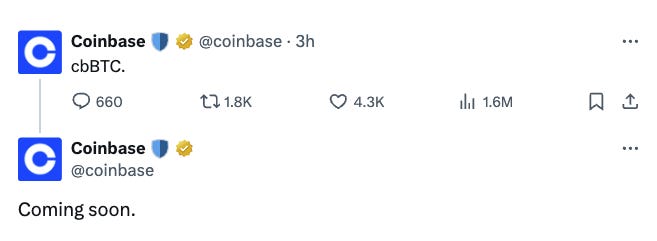Why crypto’s most polarizing figure is worrying Bitcoiners

GM,
Bitcoin is the front door to Web3, but this month it has been a major talking point after one of the industry’s most controversial figures became involved in a key asset that bridges Bitcoin to the rest of Web3: that’s wrapped BTC, aka WBTC.
This week we are exploring the drama and concerns, and explaining that this turmoil could ultimately have a positive impact on the Web3 industry.
Best,
What’s going on?
Wrapped Bitcoin (WBTC) is an essential crypto asset. It exists on multiple blockchains to represent Bitcoin that has moved from the Bitcoin blockchain to another chain. Like stablecoins, it is backed one-on-one by Bitcoin assets and held by a central custodian, BitGo.
Given that Bitcoin is the front door for Web3 and cryptocurrencies, WBTC plays an essential role enabling liquidity by moving BTC assets to other chains. Indeed, with a $9 billion market cap, it is a top 15 cryptocurrency based on value.
There are plenty of a number of emerging solutions to bridge Bitcoin natively to Ethereum, Solana and other chains, but WBTC has long been used in Web3 and people tend to prefer using what they know rather than the risk of something new, even if cost and speed savings are promised.
Recently, WBTC has become shrouded in controversy after BitGo announced plans to diversify its custodial operations through a joint venture with Hong Kong-based BiT Global which comes into force later this month. The controversy is around that joint venture, which includes participation from Justin Sun—a polarizing figure in Web3 who founded the TRON blockchain and is said to own top exchange HTX.
WBTC holders are concerned about Sun’s involvement. And they’re acting on it. MakerDAO froze new WBTC borrowing, for example, while more broadly redemptions for WBTC are reportedly 60 times higher than normal.
Let’s dive into why, what it means and what might happen in the future.
SO WHAT?
1. What does this mean?
Let’s start with Justin Sun—why are people worried about this Web3 entrepreneur’s involvement in WBTC?
For many, Sun embodies the worst traits of Web3. Whether it is destroying beloved products (Sun acquired BitTorrent, migrated it to TRON and has run it controversially), breaking financial rules (Sun illegally sold tokens to US-based investors), gaudy behavior (he once paid $1M for lunch with Warren Buffet) and other activities such as buying an ambassador role with Grenada for diplomatic immunity, alleged price manipulation and more.
WBTC is a vital product for Web3. Connecting the strong liquidity of Bitcoin to blockchains is the digital asset equivalent of providing oxygen. The vast majority of cryptocurrency market behavior correlates fairly directly to the price of Bitcoin, and Bitcoin holders are a primary focus of any chain that’s looking to drive investment.
There’s no suggestion that Sun plans to be actively involved in WBTC, but the concerns are predicated on the fact that he often finds strategic connections between his businesses, for example migrating BitTorrent to the TRON network or owning one-quarter of the assets in HTX’s reserves.
Put simply: WBTC is too important an asset for one person to cast a shadow, let alone someone as controversial as Justin Sun.
2. An inherent problem
The fact that this can even be an issue highlights a better problem with WBTC and connecting Bitcoin or any other blockchain: the current solutions are far from adequate.
WBTC, and the bridges used to move Bitcoin into WBTC are fraud with risk. We wrote last week about how North Korea hackers stole more than $600 million from Axie Infinity via a bridge that moved assets to its Ronin chain—and that risk is present for other bridges including those handling BTC-WBTC.
WBTC also goes against the core spirit of decentralization as outlined in the Bitcoin whitepaper, and the creation of other tokens and networks like Ethereum. BitGo is a prestigious name in the custody space, but it is still one entity that controls a key asset that’s responsible for significant liquidity and important asset transfers.
Relatedly, WBTC could also depeg, meaning that its value could drop below 1 BTC. That’s happened with stablecoins in times of crisis. The price of USDC fell to $0.88 in March 2023 when its issue, Circle, said it could not withdraw $3.3 billion of its $40 billion reserves from Silicon Valley Bank (SVB) following its collapse.
WBTC has endured because there’s no other solution right now, but the kerfuffle around Sun’s involvement could be a catalyst to at least finding alternative, if not better, options. And that would be a positive outcome.
3. Time for change?
A number of blockchains have emerged with solutions that could offer a more secure and less centralized solution to moving Bitcoin to other chains.
Axelar, LayerZero, ZetaChain (note: Jon is an advisor), Near and Particle Network are among the cross-chain protocols that aim to unify the ever-increasing number of blockchains in Web3 to enable assets to be transferred quickly, easily and cheaply. Bitcoin is on the list for most, but its older architecture—Bitcoin’s blockchain launched in 2009—makes it tricky to enable interoperability.
Those solutions have some way to go before they can be broadly adopted, so wrapped tokens would appear to be the solution for the here and now. But WBTC may get some competition.
Coinbase has teased the launch of cbBTC, its own take on wrapped Bitcoin, which appears to be destined for the company’s Base network initially.

Jesse Pollak, the executive who leads Base, said he wants to build “a massive Bitcoin economy” on the chain. Its own take on WBTC would be a logical place to start, but you can imagine that Coinbase has a lot more planned beyond that.
Base is Coinbase’s effort to make Web3 mainstream and, as we wrote in June, it is making impressive progress having attracted liquidity, lots of new tokens, plenty of trading and more than 5 million users.
The initial push has focused around onboarding brands and then enabling memecoins, but cbBTC could supersize that push by pulling in liquidity from Bitcoin directly and without the need for a third-party’s involvement. That aligns nicely with Coinbase’s position as the cryptocurrency exchange of choice for retail traders, and a custodian that’s trusted by enterprises and financial organizations.
Others have thrown their hat into the apparent WBTC void, but for now we will wait for 29 August when the additional WBTC custodians come online and see what happens.
News bytes
Telegram founder Pavel Durov was arrested in France over allegations that the messaging service is being used for illicit activity—it is unclear what will happen next and how its Web3 platform, TON, will be impacted
The Bitcoin halving was predicted to bring consolidation to the Bitcoin mining industry, and one firm—US-based Rhodium Enterprises—has filed for bankruptcy with liabilities of up to $100 million
Russia is reportedly close to trialing cryptocurrencies for cross-border transactions as it looks to help its companies overcome the impact of international sanctions
Sony has launched its own blockchain as well as an incubator offering grants and incentives for developers who build on the platform
Tether said that, since 2014, it has helped more than 145 law enforcement agencies worldwide recover over $108.8 million in its USDT stablecoin that was linked to illegal activities
The US state of Wyoming has pioneered a number of Web3-centric laws, including legalizing DAOs, and its next move may be its own stablecoin—it plans to launch ‘the Wyoming stable token’ in the first quarter of 2025
That’s all for this week!
Share your feedback, questions or requests via email to: sowhat@terminal3.io




